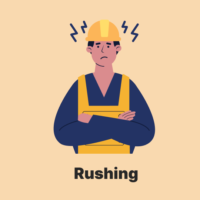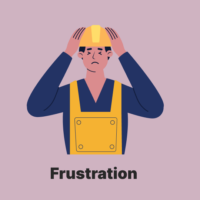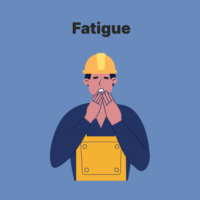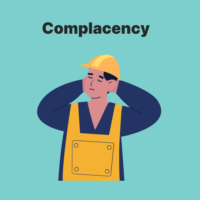How do the emotional states of people at the plant impact safety and efficiency?
“Het beestje bij zijn naam te noemen.”
Dutch saying “Call the beast by its name.”
In the safety domain, we deal with humans in various emotional states, which refers to the feelings and moods they experience and express at work. If you ask EHS people, they will name “Rushing” as a typical cause of accidents. We will add here three other possible risk-triggering emotions: “frustration,” “complacency,” and “fatigue.”
Emotional state can significantly impact safety and efficiency in manufacturing, as it can influence workers’ decision-making, behaviour, communication, and teamwork. Therefore, EHS managers need to be aware of the emotional states that can pose risks or opportunities for manufacturing operations and how to manage them effectively.
Four unsafe states of mind: rushing, frustration, fatigue, and complacency.
According to SafeStart International, a company that provides safety training and consulting, there are four common states of mind that can cause or contribute to critical errors or mistakes that lead to injuries or accidents in the workplace. These are:
Rushing
When workers feel pressured to complete a task quickly, either because of external deadlines, personal goals, or perceived expectations. Rushed people skip steps, overlook details, or take shortcuts that compromise quality and safety.


Frustration
When workers feel angry, annoyed, or irritated by something or someone at work, such as a difficult problem, not effective non-value-adding action, etc. Frustration can cause workers to lose focus, act impulsively, or lash out at others, which can create hazards.
Fatigue
When workers feel tired, sleepy, or exhausted, either because of lack of sleep, long hours, physical exertion, or mental stress. Fatigue can cause workers to have reduced alertness, impaired judgment, slower reaction time, or diminished coordination, which can affect their ability to perform tasks safely and efficiently.


Complacency
When workers feel bored, disinterested, or overconfident, either because of routine, familiarity, or experience. Complacent people pay less attention, take things for granted, or underestimate risks, which can make them miss warning signs or ignore safety rules.
These four states of mind can have serious consequences for safety and efficiency in manufacturing, as they can increase the likelihood of human error, which is a major cause of accidents and injuries in the workplace. Moreover, they can result in defects, rework, waste, or delays, which can harm the reputation and profitability of the manufacturing company.
Please read more about emotional states on the LinkedIn page by Sjoerd Nanninga:
Three causes of unsafe emotional states
These four states of mind are not random or isolated occurrences. They are often triggered or influenced by various factors in the work environment, such as:
- Workload: The amount and complexity of work that workers have to do. Too much or too little work can cause workers to feel stressed, overwhelmed, or bored, which can lead to rushing, frustration, or complacency.
- Work schedule: The timing of work that workers have to do. Irregular, unpredictable, or time-demanding tasks can cause workers to feel confused, disrupted, or exhausted, leading to complacency first and rushing after.
- Work culture: The values, practices, and engagement workers experience at work. A positive, supportive, and inclusive work culture can foster workers’ enthusiasm, satisfaction, and comfort, while a hostile or indifferent work culture can undermine workers’ motivation, morale, and well-being, with frustration or complacency as a result.
The importance of effective process
A clear and transparent process can be achieved by applying the lean methodology to safety processes. Lean methodology aims to reduce waste and increase value for customers by eliminating activities that do not add any value for the customer.
This is how applying five key principles of Lean helps in the EHS domain to manage the emotional states of workers and to get improved safety and efficiency as a bonus:
✅ Value: clearly understand the purpose and expectations of tasks.
✅ Value stream: see the whole picture of the process.
✅ Flow: follow the smooth and uninterrupted flow through the value stream.
✅ Pull: perform tasks only when they are requested.
✅ Perfection: pursuit of improvement and excellence.
Read more about how to apply Lean to Safety here: Apply lean methodologies to improve safety
How to manage unsafe states of mind for a safer and more efficient work environment
The good news is that these four states of mind are not inevitable or irreversible. There are ways to prevent, reduce, or cope with them, both at the organizational and individual levels.
Here are some suggestions:
-> Plan and allocate work in a realistic and balanced way, considering the value delivered and avoiding overloading or underutilizing people.
-> Manage time, prioritize tasks, set realistic, attainable, and measurable goals, and break down complex or large tasks into smaller and simpler ones.
-> Create and maintain an engaging work culture that values, supports, and respects workers, encouraging them to communicate, collaborate, learn, and contribute.
-> Standardize and automate repetitive actions and flows so that people can focus on tasks that require creativity, problem-solving, or human interaction.
Conclusion
Emotional state is a critical factor that affects safety and efficiency in manufacturing.
By being aware of the four unsafe states of mind that can cause or contribute to critical errors or mistakes and by applying the strategies to manage them effectively, managers and workers can create a safer and more efficient work environment where they can perform their tasks with confidence, competence, and satisfaction.
Technology and digitalization is a great means to support people. Read more here: Digitalization can make people think




